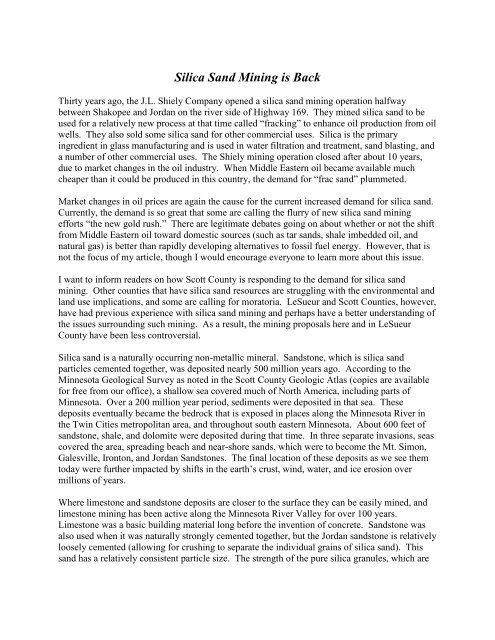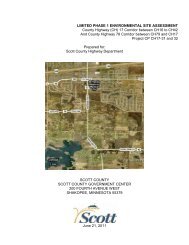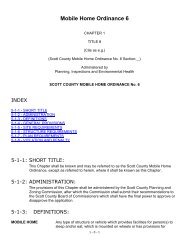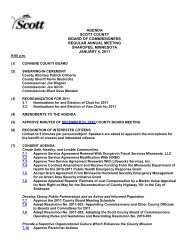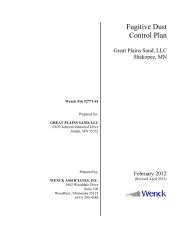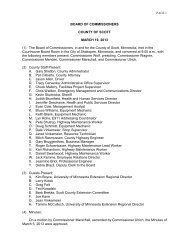Silica Sand Mining is Back - Scott County
Silica Sand Mining is Back - Scott County
Silica Sand Mining is Back - Scott County
You also want an ePaper? Increase the reach of your titles
YUMPU automatically turns print PDFs into web optimized ePapers that Google loves.
<strong>Silica</strong> <strong>Sand</strong> <strong>Mining</strong> <strong>is</strong> <strong>Back</strong><br />
Thirty years ago, the J.L. Shiely Company opened a silica sand mining operation halfway<br />
between Shakopee and Jordan on the river side of Highway 169. They mined silica sand to be<br />
used for a relatively new process at that time called “fracking” to enhance oil production from oil<br />
wells. They also sold some silica sand for other commercial uses. <strong>Silica</strong> <strong>is</strong> the primary<br />
ingredient in glass manufacturing and <strong>is</strong> used in water filtration and treatment, sand blasting, and<br />
a number of other commercial uses. The Shiely mining operation closed after about 10 years,<br />
due to market changes in the oil industry. When Middle Eastern oil became available much<br />
cheaper than it could be produced in th<strong>is</strong> country, the demand for “frac sand” plummeted.<br />
Market changes in oil prices are again the cause for the current increased demand for silica sand.<br />
Currently, the demand <strong>is</strong> so great that some are calling the flurry of new silica sand mining<br />
efforts “the new gold rush.” There are legitimate debates going on about whether or not the shift<br />
from Middle Eastern oil toward domestic sources (such as tar sands, shale imbedded oil, and<br />
natural gas) <strong>is</strong> better than rapidly developing alternatives to fossil fuel energy. However, that <strong>is</strong><br />
not the focus of my article, though I would encourage everyone to learn more about th<strong>is</strong> <strong>is</strong>sue.<br />
I want to inform readers on how <strong>Scott</strong> <strong>County</strong> <strong>is</strong> responding to the demand for silica sand<br />
mining. Other counties that have silica sand resources are struggling with the environmental and<br />
land use implications, and some are calling for moratoria. LeSueur and <strong>Scott</strong> Counties, however,<br />
have had previous experience with silica sand mining and perhaps have a better understanding of<br />
the <strong>is</strong>sues surrounding such mining. As a result, the mining proposals here and in LeSueur<br />
<strong>County</strong> have been less controversial.<br />
<strong>Silica</strong> sand <strong>is</strong> a naturally occurring non-metallic mineral. <strong>Sand</strong>stone, which <strong>is</strong> silica sand<br />
particles cemented together, was deposited nearly 500 million years ago. According to the<br />
Minnesota Geological Survey as noted in the <strong>Scott</strong> <strong>County</strong> Geologic Atlas (copies are available<br />
for free from our office), a shallow sea covered much of North America, including parts of<br />
Minnesota. Over a 200 million year period, sediments were deposited in that sea. These<br />
deposits eventually became the bedrock that <strong>is</strong> exposed in places along the Minnesota River in<br />
the Twin Cities metropolitan area, and throughout south eastern Minnesota. About 600 feet of<br />
sandstone, shale, and dolomite were deposited during that time. In three separate invasions, seas<br />
covered the area, spreading beach and near-shore sands, which were to become the Mt. Simon,<br />
Galesville, Ironton, and Jordan <strong>Sand</strong>stones. The final location of these deposits as we see them<br />
today were further impacted by shifts in the earth’s crust, wind, water, and ice erosion over<br />
millions of years.<br />
Where limestone and sandstone deposits are closer to the surface they can be easily mined, and<br />
limestone mining has been active along the Minnesota River Valley for over 100 years.<br />
Limestone was a basic building material long before the invention of concrete. <strong>Sand</strong>stone was<br />
also used when it was naturally strongly cemented together, but the Jordan sandstone <strong>is</strong> relatively<br />
loosely cemented (allowing for crushing to separate the individual grains of silica sand). Th<strong>is</strong><br />
sand has a relatively cons<strong>is</strong>tent particle size. The strength of the pure silica granules, which are
approximately the size of sugar granules contribute to its value in an oil well enhancement<br />
process called hydraulic fracturing or “fracking.” You can research th<strong>is</strong> on your own.<br />
What are the environmental implications associated with mining silica sand Largely, the<br />
answer to th<strong>is</strong> question <strong>is</strong> that they are the same as mining sand, gravel, or limestone with a few<br />
additional concerns related to unique settings. The Jordan sandstone formation throughout<br />
southeastern Minnesota serves as a valuable source of drinking water called the Jordan aquifer.<br />
<strong>Sand</strong>stone <strong>is</strong> porous, and the open spaces between the sand grains hold water which can easily be<br />
tapped by a well and pumped out. Water flows through sandstone formations relatively easily,<br />
allowing for infiltration and underground migration toward d<strong>is</strong>charge points. Here in <strong>Scott</strong><br />
<strong>County</strong>, the primary d<strong>is</strong>charge point for the Jordan aquifer <strong>is</strong> the Minnesota River. Because it<br />
serves as an aquifer, concerns about mining into it always include concerns about impacts to<br />
drinking water resources. The proposed mines are adjacent to the aquifer’s natural point of<br />
d<strong>is</strong>charge, minimizing the potential for adverse impacts.<br />
<strong>Mining</strong> always involves the transport of products, so traffic concerns must be addressed. In the<br />
case of the two proposed mines, the primary means of transporting their silica sand product (frac)<br />
will be by rail. Th<strong>is</strong> will result in several additional trains through Shakopee every day.<br />
Similarly, the mines in LeSueur <strong>County</strong> will be increasing their output of silica sand being railed<br />
through Shakopee.<br />
<strong>Mining</strong> generally also involves increased r<strong>is</strong>k for dust problems; with silica, like some other<br />
minerals including asbestos, these dust particles have been shown to be associated with<br />
respiratory problems, especially the smaller particles that are sharp edged and can lodge in the<br />
lungs. The condition called silicos<strong>is</strong> has been well documented, especially among workers<br />
exposed to th<strong>is</strong> dust in high concentrations for long periods of time. <strong>Silica</strong> <strong>is</strong> one of the most<br />
common minerals on earth, so everyone <strong>is</strong> exposed to silica dust. Exposure to silica dust <strong>is</strong><br />
regulated by several agencies in the United States for workers through the Occupational Safety<br />
and Health Agency (OSHA) and the Mine Safety and Health Admin<strong>is</strong>tration (MSHA). In<br />
addition, in Minnesota, exposure to surrounding populations from sources regulated through air<br />
quality permits (as these mines will be) <strong>is</strong> regulated in the form of nu<strong>is</strong>ance dust by the<br />
Minnesota Pollution Control Agency. Monitoring and dust controlling mitigation plans will be<br />
required of these mines to minimize dust problems.<br />
Additional concerns from mining in general include no<strong>is</strong>e and blasting impacts to surrounding<br />
property through ground waves or air blast impacts. Considering that blasting of limestone in the<br />
areas being proposed for silica sand mining has been going on for decades without significant<br />
<strong>is</strong>sues demonstrates that both no<strong>is</strong>e and blasting impacts can be controlled adequately.<br />
<strong>Scott</strong> <strong>County</strong> just completed an Environmental Assessment Worksheet (EAW) for the Great<br />
Plains <strong>Sand</strong> mining project at the location of the previous J. L. Shiely mine that closed 20 years<br />
ago. By the time th<strong>is</strong> article <strong>is</strong> publ<strong>is</strong>hed, it <strong>is</strong> anticipated that an Interim Use Permit (IUP) will<br />
have been <strong>is</strong>sued as well with conditions establ<strong>is</strong>hed to address all of the concerns identified<br />
through the EAW process and additional <strong>is</strong>sues that came to light during the IUP process. That<br />
permit will be held somewhat open to enable adding additional conditions as deemed necessary<br />
to protect the public. A Great Plains <strong>Sand</strong> Adv<strong>is</strong>ory Committee will also have been created
cons<strong>is</strong>ting of representatives from <strong>Sand</strong> Creek and Lou<strong>is</strong>ville Township, the project developer<br />
and <strong>Scott</strong> <strong>County</strong> with others such as representatives from the adjacent U.S. F<strong>is</strong>h and Wildlife<br />
Refuge participating as needed. Th<strong>is</strong> adv<strong>is</strong>ory committee will review operations and recommend<br />
changes to the IUP conditions and to the mine operator to address concerns which may ar<strong>is</strong>e.<br />
The other and much larger mining proposal <strong>is</strong> the Merriam Junction <strong>Sand</strong>s proposed for the area<br />
previously occupied by Bryan Rock, River Warren Rock, the Rena<strong>is</strong>sance Festival, and other<br />
properties adjacent compr<strong>is</strong>ing almost 1,000 acres. That project because of its size <strong>is</strong> subject to<br />
preparation of a much more intensive analys<strong>is</strong> called an Environmental Impact Statement (EIS).<br />
That <strong>is</strong> still being prepared and will provide several opportunities for public review and<br />
comment.<br />
<strong>Scott</strong> <strong>County</strong> has always held the rights and safety of the public as the highest priority. The<br />
focus of the <strong>County</strong> Board <strong>is</strong> to ensure “safe, healthy. and livable Communities.” The approach<br />
to preparing the environmental review documents for the silica sand mines involved an increased<br />
effort to collaborate with the township officers providing interested citizens additional<br />
opportunities to communicate their concerns through their closest elected officials. The<br />
environmental review process as well as the Interim Use Permit process <strong>is</strong> open to public<br />
participation. Documents available for public review and comment are posted on the <strong>County</strong>’s<br />
website: just click on the scrolling notice called “<strong>Silica</strong> <strong>Sand</strong> <strong>Mining</strong> Proposals.” You can<br />
receive automatic emailed notification of new postings about these projects by subscribing<br />
through E-Services. Check th<strong>is</strong> out at www.co.scott.mn.us.


